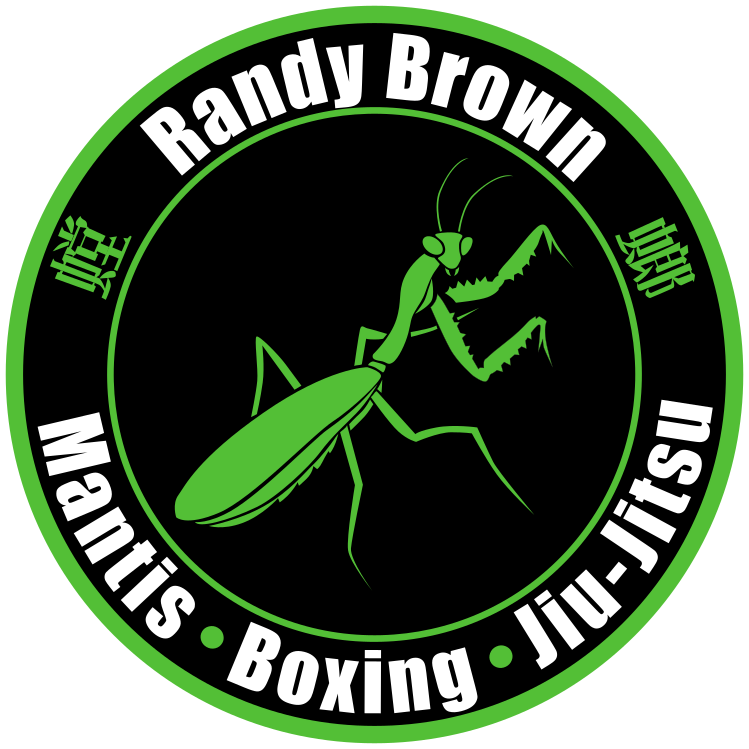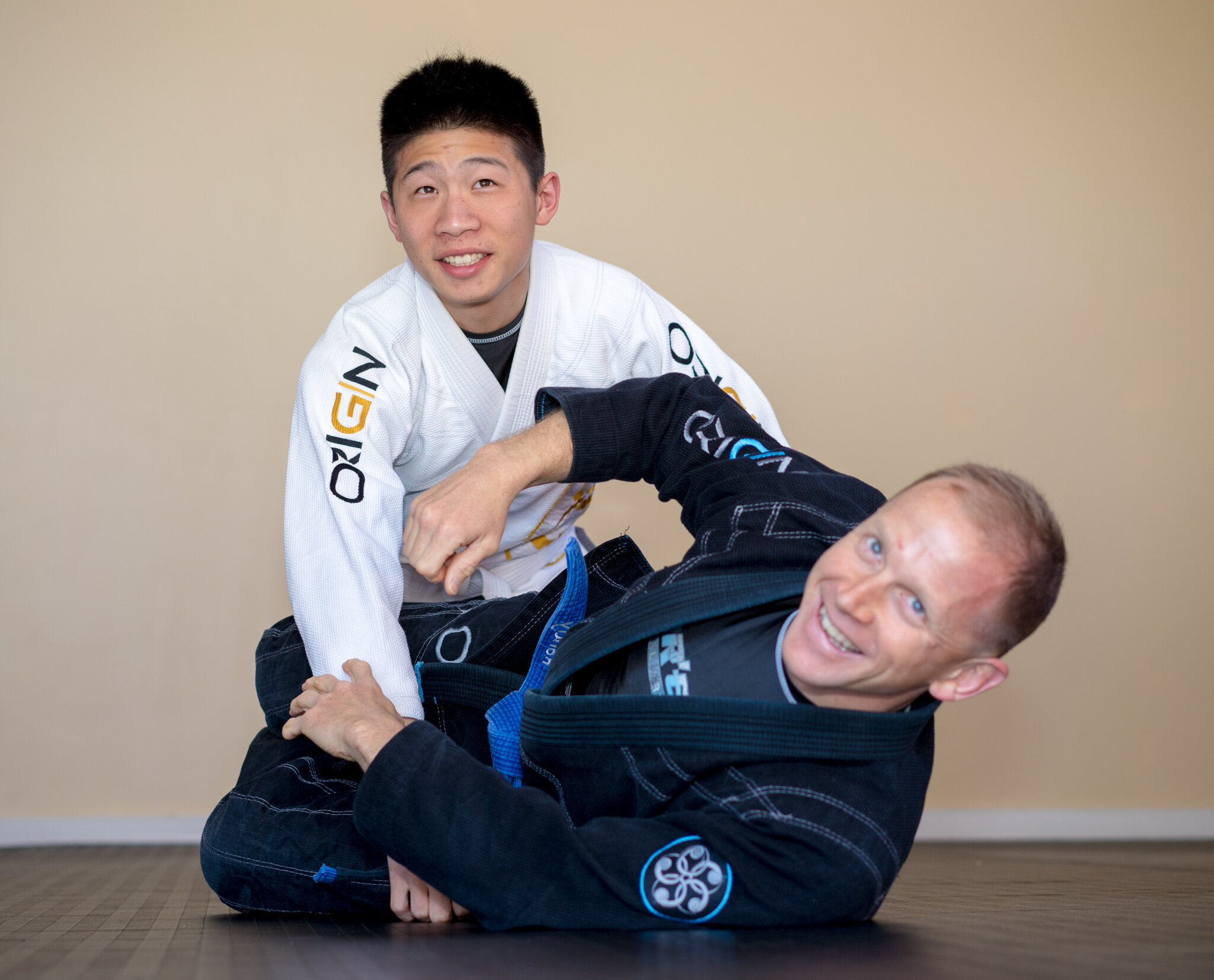photos by Max Kotchouro
The following dust-covered article I originally wrote for another blog back in 2012-13 as a Brazilian jiu-jitsu (BJJ) blue belt. My hopes/intent for this article are still the same — helping you, and others like you, who avoid training or even trying BJJ due to the lack of enthusiasm of other people touching you, Whether you are a beginner, or a veteran martial artist, I’d like to help you understand BJJ by sharing a bit of my reluctance to dive into it and my experience traversing the art, while having the same reservations at the start.
Randy - 2020. Thank you.
Let me get this out of the way from the start - I emphatically hate people touching me. I have issues with physical contact, space invaders, and touchy-feely nonsense. After many failed attempts at coping, I simply avoid large crowds, parties, grandmas, and priests. Chalk it up to a plethora of personal experiences early in life, or just laugh and call me strange. Getting my finger lobbed off in a table saw was a more a preferable experience than some weird inebriated schmuck trying to grope me at a party. (FYI - a good use for martial arts training)
Now that I’ve made it abundantly clear how much I dislike physical contact, perhaps no we can relate to one another. I imagine if you are still reading this for any other reason than to make fun of me then you have similar issues with physical contact, and this reason has been a primary deterrent to you experimenting with Brazilian jiu-jitsu in the first place. Or, you just really hate Brazilian jiu-jitsu and clicked on this artile in the hopes of reading a series of bad things I have to say about it. Spolier alert: it is not going to go your way so you can bail now and save yourself some time.
False Fears
The idea of having to work closely with someone else, especially on the ground, used to 'skeeve me out'. There is a stark differential between the modalities I was accustomed to - striking, kicking, and takedowns, when contrasted to rolling around on the ground with another human being while wearing pajamas or skin tight clothing.
Knowing what I know now, I probably would have loved high school wrestling, but that was never going to happen. Many foes would have fallen trying to force my fat, chubby, adolescent self into one of those onesie singlets.
Fast forward to later in life, having trained mantis boxing for ten plus years and running a school for five of those, and during this time I became distinctly aware of the giant deficiency in mantis boxing - the lack of a ground game.
I discussed this reality with one of my coaches at the time. Being practical and grounded in real-world experience he agreed with the problem and suggested that I take up BJJ, to at least a blue belt level. The blue belt being a significant achievement in the art of Brazilian jiu-jitsu, showing an individual has gone through the grist mill and survived to a base level of proficiency in self=defense on the ground.
The goal of reaching this belt in his assessment was that, I would have the experience and know-how to deal with an altercation on the ground; if a fight ever ended up there. Which, anecdotally speaking, they usually do.
I was reluctant at first (see aforementioned comments on personal space) but eventually I capitulated and decided to try it out. To say my first attempts did not go well is a mild understatement [insert sarcasm].
Unfortunately, my first couple of experiences went horribly awry. I unknowingly chose the wrong coaches/schools to train with and this produced catastrophic results. To include but not limited to, a ripped ear, tweaked elbow; broken toe, and a severe shoulder injury that costs thousands of dollars in rehab and will someday ultimately require a full shoulder replacement. I’m holding out for stem cells or cybernetic arms to become a mainstay.
On the third attempt to learn Brazilian jiu-jitsu I found a great instructor and the perfect atmosphere to train and learn the art. The coach was friendly, welcoming, and understanding of the fact that I was starting over in a new art. He was patient as well, and willing to help me enter this martial art without getting trashed before knowing which end is up. One of the ways this varied from prior attempts, was the premise of not having me roll the first class, or even the first weeks/months of training. His words - “I need to teach you how to roll before we start rolling.” - Dedeco. Wise words. Everywhere else I had been, it was sparring from day one, and people just trying to mop the floor with me.
Ignorance is Bliss
Holly smashing it at Boston Summer Open 2013
‘Traditional’ martial arts styles are mostly comprised of arts originating from east asia, but for our purposes we’ll include western boxing, kickboxing, muay thai, shuai jiao, and more. A vast majority of these styles strictly cover stand-up fighting - striking, kicking, throwing, and maybe joint locks.
With the exception of wrestling, how do any of these styles account for a larger, stronger, opponent that wants nothing more than to put us on the ground and pummel us? The all subsist around weight class rule structures.
A sound and well rounded martial artist in my opinion, wants solutions for these problems. Problems such as being stuck underneath someone that has 100lbs of body weight on us, is choking us, or is pummelling us with fists while sitting on our torso.
We want not only to survive, but to thrive in these situations. I have to be frank here - I have seen a variety of nonsensical comments from traditional martial artists when it comes to this very real threat. A belief in their minds that the threat of someone controlling us is not real, or that arts such as BJJ are useless. These statements include comments such as -
"I will use my eye gouges, groin strikes, and secret pressure point attacks." - anonymous
No. No you most likely won't. You will be too busy trying to figure out which way is up; panicking to get back to your feet, trying to breath as you gas yourself out (the ground is stressful), and performing silent math calculations on how much your opponent really weighs while they crush the soul out of your body with unrelenting pressure.
Another comment I see -
"I won't let them get me on the ground." - anonymous
Yes. Yes, you will. If the inherent nature of their style, the sole purpose of their modality of fighting is designed to get you on the ground, then you will be on the ground. No doubt about it. Especially if they have been training for years to accomplish said goals.
“But I train takedown defense.”
We live in the northeast where snow and ice are prevalent for a large portion of the year. Ending up on the ground is a common mishap for us even without someone violently assisting us in the process. Bottom line - as a traditional martial artist or someone with no experience in fighting, we benefit by recognizing the holes in our systems and learning to close these weaknesses. We gain nothing but darkness…and oxygen deprivation by hiding our head in the sand.
“Adapt and Overcome”
“Adapt and overcome.” A common phrase we heard consistently in boot camp. If we are experienced martial artists, adding Brazilian jiu-jitsu to our game only improves, not detracts, from our primary art. Depending on the style we practice, we may come from arts afflicted by transmission loss. Meaning some, or all, of the techniques have been lost through the annals of time. We’re left only with forms/kata, and best guesses as to the original method(s) of execution. Putting the pieces back together can be difficult to downright impossible. Finding crossover principles and techniques in other arts such as BJJ can help link things together in our brain, and improve our primary style of choice.
BJJ has decidedly helped me learn more about my own style of mantis boxing. From takedowns, to defense, to even just kinesthetically putting pieces together to flow. It has taken my knowledge, my game to a whole new level. This is especially relevant to an art such as mantis boxing, one of many Chinese boxing styles that is rooted in stand-up grappling, and riddled with principles that crossover to BJJ.
Perhaps you are fortunate and train with a school/coach team that has all the applications of your style already intact. Handed down to you in clear drills, and efficient training that turns you into a competent fighter. However, if that art still lacks a ground solution, as my art did, then this is the perfect reason to undertake BJJ, wrestling, or catch wrestling to shore up those weaknesses.
Donut, or Do Not?
Donut eating me - 2006
Here are a few more benefits of learning BJJ. Traditional martial arts teachers across America are known for being out of shape. I have seen it at countless tournaments since the early days of competing. A few years later, I myself was overweight while owning and running my school. I ballooned out, and knew deep down that I was setting a bad example to my students on how I personally believe a martial artist should live.
Another saying from the military - “fit to fight”. The truth to this is so base and fundamental. I’ve fought, sparred, won, and lost to some very good fighters over the years. Some of those individuals were grossly out of shape. After 30 to 90 seconds of maneuvering, or light tangling, they were huffing and puffing, buckled over and gassed beyond function. The amazing skills and techniques they had, were rendered useless by lack of stamina to stay operational long enough to use them.
Imagine for a moment, Special Forces operators dropped miles from their target behind enemy lines. They have to march to their battle positions before engaging the enemy. If they are unfit for duty, or out of shape, then any gear hauling, or arduous obstacles in their path, would render them inoperable by the time they reach their mission objective. What’s the point? Hand-to-hand combat is no different. If we’re out of shape, we’re ineffective, or less effective.
How can we stand with our heads high, selling, or marketing fitness, exercise, discipline, along with our self-defense, when we are stuffing donuts down our throat, or puffing cigarettes out behind our dojo? If we are out of shape ourselves, then we are nothing more than an exemplary display of hypocricy. “Do as I say, not as I do.”
How can BJJ change this? Brazilian jiu-jitsu is an incredible workout. It engages the full body. Exercising almost every muscle in our physical anatomy, including our brain. It takes serious conditioning to roll with another person for an entire class, or for a 5 minute bout at a competition. Just try and eat a jelly donut before walking out on the mats. Actually…don’t. Please don’t. Your partner doesn’t want to wear a Boston creme on their gi, and will likely give you a “vanilla nut tap” if you adorn them with an ‘already been chewed’ ball of dough and jam.
Before I ever reached my first BJJ tournament match, I had many stand-up sparring sessions and amateur bouts. I was no stranger to the exhaustion and fatigue that takes place shortly after an altercation ensues. Much of our training, and sparring in a dojo, is basic inoculation to the stress of what we are going to face for real. Even so, I had absolutely no idea what I was going to encounter in my first BJJ match.
An IBJJF (International Brazilian Jiu-Jitsu Federation) tournament has more 6 packs than you'll find at a redneck BBQ.
When grappling is involved, it is a completely different world, and the intensity is magnified ten-fold. The proximity stress; gripping, tugging, and pushing; all when we’re still on our feet at the beginning of a match, drains our reserves. By the time we land on the ground, we’re seconds away from being face to face with the ‘adrenaline dump’ (all energy fades from our body). When this hits, there is nothing left in the tank; we’re completely gassed. Left only with our willingness to give up; or survive. This…is why an IBJJF (International Brazilian Jiu-Jitsu Federation) tournament has more 6 packs than you'll find at a redneck BBQ. It’s an incredible workout.
What better way to exercise than to have fun, and learn while ‘getting into’, or ‘staying in’ shape? Enjoyment and mental engagement are a necessary function to stay committed to any type of physical activity we choose. BJJ will help us shred fat, build cardio, strength, and keep or return that weaponized body we once aspired to through joining martial arts in the first place. Of course, the nutrition aspect has to go along with it, but the mat time we put in, will incentivize us to eat better so we don’t gas out.
The ‘BEST’ Pie is ‘Humble’ Pie
Chin Na training - circa 2000
The saying is - "the mats don't lie." This means simply, that when we walk out on the mats, we can't say we are something we are not and get away with it for long. When we roll with another grappler, the truth becomes abundantly clear who is the higher hand.
"The mats don't lie."
Being a part of the ‘traditional martial arts world’ through the rise of the internet, from BBS's, to forums, to facebook, etc., I have seen more petty arguments and nonsensical statements about -
"My style is the greatest".
"I'm better than you."
"I know more forms than you."
“I’ve trained longer than you.”
"My lineage is pure, look who you studied with."
“I trained in {insert country of origin].”
"My teacher is better than your teacher.”
“My grandmother was better than your teacher"
It’s ‘ok’ to get a little mud on our face. Just smile and move on.
...and on, and on it goes. It is downright embarrassing and pathetic to see this behavior from (grown adults, usually males) martial artists. So-called warriors, or those aspiring to be. People who train their whole lives to be more than the average person, yet demean themselves beneath others on the internet for the world to see. The individual makes the art. No one else.
In contrast, I have met some of the nicest people in BJJ since I have been a part of this art. Sure, there are jerks (I met a few in the first couple attempts at starting out), but the majority of people, by and large, are polite, grounded, and pretty darn cool.
Why the difference? Simple really. We have to put our money where our mouth is. We can make claims to ourselves, or others about our prowess, and skill, but the truth comes out on the mats. Each roll, we’re face to face with our own strengths, and weaknesses; whether we’re ready to receive them or not. This is a humbling experience and not for the faint of heart. It requires complete honesty with the most important person listening to us - ourselves.
"In my experience, the more dangerous two people are, the more respectful they are to one another." - Dedeco
BJJ, along with any other contact based martial arts, keeps us humble and aware that we are all just students of the martial arts, even when coaching and helping others. We know in our hearts, and minds, that there are always bigger fish in the ocean. We all have progress to make in bettering ourselves inside and out. Even if we are king, or queen of our own little sandbox, getting tapped out by a smaller opponent or a BJJ white belt, gives us firsthand knowledge and experience in one of the most important martial arts principles to aspire to - humility.
Enjoyment of Challenge
Finally, what makes all the physical contact worth it? Honestly, the contact/space, is not that big of a deal a week or so after training. It is a far different experience rolling and grappling with someone, working with them to better ourselves, or having them try to choke us rather than grope us. Anyway, it's just downright fun, super challenging, mentally engaging, and packed with years of intrigue. There are not many sports that can produce that.
A plethora of the techniques (sweeps, submissions, escapes, takedowns) are extremely awesome and a thrill to learn. We mistake them for magic when we first see them, but the best part is when we succeed at working the magic ourselves after much trial and tribulation.
I know first hand as a student, and coach, that we have to keep the training fun in order to stay energized about teaching. So if you are already a teacher of another discipline, training BJJ gives us a newfound sense of excitement. The same we had when we were a novice student in our original martial art style, when everything was new and enchanting. Personally, I found it helped to keep the fires burning in myself, reigniting a dwindling flame in the art I had already dedicated years of practice and teaching to prior to entering BJJ.
Teaching others is rewarding and fun, but if we are not continuing to learn and grow we can become stagnant, bored, disenchanted, and even bitter. These are a few reasons I highly recommend trying out BJJ for martial artists from other modalities. Try adding it to your game and see for yourself.
Put on that ‘white belt’, box up the ego, and take the plunge into a fascinating world of new friends, sweet techniques, and years of humble learning. You won't regret it.







